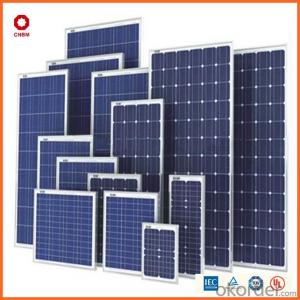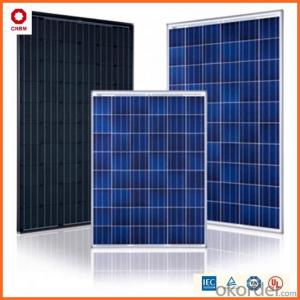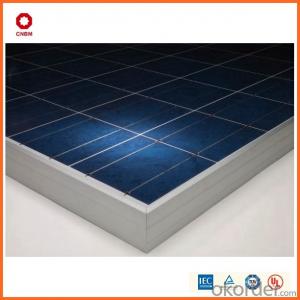Small Solar Panel 55w Poly with Good Quality
- Loading Port:
- China main port
- Payment Terms:
- TT OR LC
- Min Order Qty:
- 1 watt
- Supply Capability:
- 10000000 watt/month
OKorder Service Pledge
OKorder Financial Service
You Might Also Like
Item specifice
Product Description:
Hot Sale !!! Quality and Safety of Small Poly Solar Panel 35~85w
1. Rigorous quality control meets the highest international standards.
2. High-transmissivity low-iron tempered glass, strong aluminium frame.
3. Using UV-resistant silicon.
4. IS09001/14001/CE/TUV/UL
Warranties of Small Poly Solar Panel 35~85w
1. 10 years limited product warranty
2. 15 years at 90% of the minimal rated power output
3. 25 years at 80% of the minimal rated power output
Specification
Characteristics of Poly solar panels CNBM (245-320W) | |||||
Max Power Voltage Vmp(V) | 30.3 | 30.8 | 31.1 | 31.4 | 31.85 |
Max Power Current Imp(A) | 7.60 | 7.64 | 7.73 | 7.81 | 7.85 |
Open Circuit Voltage Voc(V) | 36.1 | 36.6 | 37 | 37.3 | 37.68 |
Short Circuit Current Isc(A) | 8.50 | 8.55 | 8.65 | 8.75 | 8.85 |
Max Power Pm(W) | 230W | 235W | 240W | 245W | 250W |
Temperature Coefficient of Cells Poly solar panels CNBM (245-320W) | |
NOCT | 45± 2 |
Temperature Coeffucients of Isc | 0.0492 |
Temperature Coeffucients of Voc | -0.3374 |
Temperature Coeffucients of Voc | -0.4677 |
Mechanical Data of Poly solar panels CNBM (245-320W) | |
Dimension | 1638 × 982 × 40 mm |
Weight | 19.5 kg |
No. of Cells and Connections | 60 (6 ×10) |
Tolerance | 0 ~ + 5 W |
Cell | Monocrystalline Cell 156 × 156 mm |
Packing | 624 Pcs/40ft(H) Container |
Limits of Poly solar panels CNBM (245-320W) | |
Operating Temperature | -40 to +85 |
Storage Temperature | -40 to +85 |
Max System Voltage | 1000VDC(IEC) / 600VDC(UL) |
Features of our products:
• High conversion efficiency mono/poly-crystalline amorphous silicon solar cells
• Modules incorporate high performance bypass diodes to minimize the power drop caused by shading
• High transmittance, low-iron tempered glass
• High performance EVA encapsulant to prevent destroying and water.
• AI frame: without screw, corner connection. 8 holes on the frame can be installed easily
• Good performance of preventing from atrocious weather such as wind and hails
• Certifications: CE IEC TUV VDE UL, Class I
• 10 years 90% power output warranty

Shipping of Small Poly Solar Panel 35~85w
By Sea | Delivery from Shanghai or Ningbo seaport |
By Air | Departure from Shanghai Pudong Airport |
By Express | Post by DHL, EMS, UPS, TNT. |
- Q:How much energy can a solar energy system generate?
- The amount of energy a solar energy system can generate depends on several factors, including the size and efficiency of the system, the location and climate conditions, and the amount of sunlight available. However, on average, a well-designed solar energy system can generate enough electricity to power a home or a building, and in some cases, even generate surplus energy that can be fed back into the grid.
- Q:What is the maintenance cost of a solar energy system?
- The maintenance cost of a solar energy system can vary depending on factors such as the size of the system, the type of panels used, and the location. However, in general, the maintenance cost of a solar energy system is relatively low. It mainly involves regular cleaning of the panels to ensure optimal efficiency and occasional inspection of the system components. Additionally, periodic servicing and potential repairs may be necessary over the lifespan of the system. Overall, the maintenance cost is typically considered minimal compared to the long-term savings and environmental benefits provided by solar energy.
- Q:Can solar panels be used to charge mobile devices?
- Yes, solar panels can be used to charge mobile devices.
- Q:How does the angle of incidence affect the performance of solar panels?
- The angle of incidence greatly affects the performance of solar panels. When the angle of incidence is optimal (usually perpendicular to the sun's rays), solar panels can generate maximum power output. However, as the angle deviates from the optimal position, the power output decreases. Therefore, it is crucial to adjust the angle of solar panels to optimize their performance and maximize energy production.
- Q:Are there any risks of electrical shocks during installation or maintenance of solar energy systems?
- Yes, there are risks of electrical shocks during the installation or maintenance of solar energy systems. These risks can occur due to the high voltage of the system, improper grounding, faulty wiring, or inadequate safety precautions. It is crucial to follow proper safety procedures, use appropriate personal protective equipment, and ensure that qualified professionals handle the installation and maintenance to minimize the risk of electrical shocks.
- Q:Can solar energy systems be used to power boats or yachts?
- Yes, solar energy systems can indeed be used to power boats or yachts. Solar panels can be installed on the roof or deck of a boat to capture sunlight and convert it into electricity. This electricity can then be used to power various onboard systems, such as lights, navigation equipment, communication devices, refrigeration, and even propulsion systems. The size and capacity of the solar energy system will depend on the specific power requirements of the boat or yacht, as well as the available space for installation. Solar-powered boats and yachts offer several advantages, including reduced reliance on fossil fuels, lower operational costs, quieter operation, and reduced carbon emissions. However, it is important to note that solar energy alone may not be sufficient to power larger vessels or during prolonged periods of low sunlight. In such cases, a hybrid system that combines solar energy with other power sources, such as wind or diesel generators, may be more suitable.
- Q:Are there any safety concerns with solar energy systems?
- Yes, there are a few safety concerns with solar energy systems. The major concern is the risk of electrical shock or fire due to improper installation or maintenance. Additionally, there is a potential hazard associated with the use of toxic materials, such as certain chemicals used in the manufacturing of solar panels. However, these risks can be minimized through proper installation by qualified professionals and regular inspections and maintenance.
- Q:Can solar energy systems be used for powering transportation systems?
- Yes, solar energy systems can be used for powering transportation systems. Solar panels can be installed on vehicles, such as cars, buses, and even boats, to generate electricity and charge batteries. This renewable energy source can help reduce greenhouse gas emissions and dependence on fossil fuels in the transportation sector. Additionally, solar-powered charging stations can be installed along roadways to provide electricity for electric vehicles, further promoting sustainable and clean transportation.
- Q:Can solar energy systems be installed on agricultural land?
- Yes, solar energy systems can be installed on agricultural land. In fact, installing solar panels on farmland can provide dual benefits by generating clean energy while still allowing for agricultural activities to continue. This practice, known as agrivoltaics or solar farming, has gained popularity as it maximizes land use efficiency and promotes sustainable practices.
- Q:Can a solar energy system be installed on a building with multiple levels?
- Installing a solar energy system on a building with multiple levels is indeed possible. The installation process relies on several factors, including the available space, orientation, and structural integrity of the building. In the case of multi-level buildings, solar panels can be placed on the roof, balconies, or other suitable areas that receive sufficient sunlight. To optimize energy generation, it may be necessary to install multiple solar arrays on different levels, depending on the building's design and layout. Additionally, it is crucial to ensure that the building's electrical infrastructure can support the installation of a solar energy system. By carefully considering and planning the building's characteristics, a successful installation of a solar energy system on a multi-level building can be achieved.
1. Manufacturer Overview |
|
|---|---|
| Location | |
| Year Established | |
| Annual Output Value | |
| Main Markets | |
| Company Certifications | |
2. Manufacturer Certificates |
|
|---|---|
| a) Certification Name | |
| Range | |
| Reference | |
| Validity Period | |
3. Manufacturer Capability |
|
|---|---|
| a)Trade Capacity | |
| Nearest Port | |
| Export Percentage | |
| No.of Employees in Trade Department | |
| Language Spoken: | |
| b)Factory Information | |
| Factory Size: | |
| No. of Production Lines | |
| Contract Manufacturing | |
| Product Price Range | |
Send your message to us
Small Solar Panel 55w Poly with Good Quality
- Loading Port:
- China main port
- Payment Terms:
- TT OR LC
- Min Order Qty:
- 1 watt
- Supply Capability:
- 10000000 watt/month
OKorder Service Pledge
OKorder Financial Service
Similar products
New products
Hot products
Related keywords






























